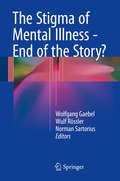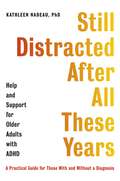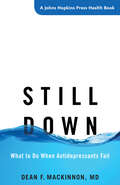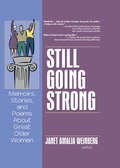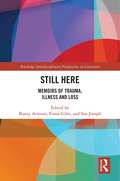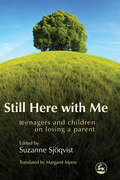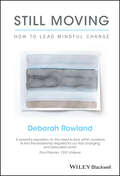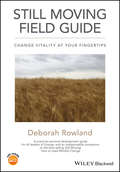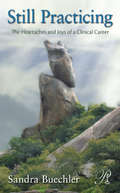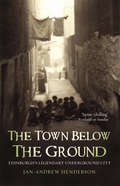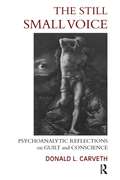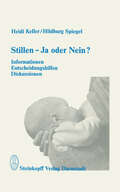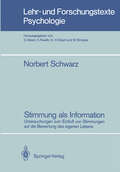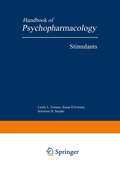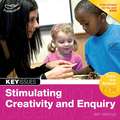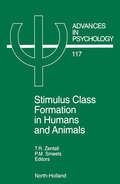- Table View
- List View
The Stigma of Mental Illness - End of the Story?: End Of The Story?
by Wolfgang Gaebel Wulf Rössler Norman SartoriusThis book makes a highly innovative contribution to overcoming the stigma and discrimination associated with mental illness – still the heaviest burden both for those afflicted and those caring for them. The scene is set by the presentation of different fundamental perspectives on the problem of stigma and discrimination by researchers, consumers, families, and human rights experts. Current knowledge and practice used in reducing stigma are then described, with information on the programmes adopted across the world and their utility, feasibility, and effectiveness. The core of the volume comprises descriptions of new approaches and innovative programmes specifically designed to overcome stigma and discrimination. In the closing part of the book, the editors – all respected experts in the field – summarize some of the most important evidence- and experience-based recommendations for future action to successfully rewrite the long and burdensome ‘story’ of mental illness stigma and discrimination.
Still Distracted After All These Years: Help and Support for Older Adults with ADHD
by Kathleen NadeauThe world's foremost expert shares advice on later-in-life ADHD, tackling everything from finances, parenting, planning for retirement, social life and work, in this practical and helpful guide for those with and without a diagnosis.Do you...· Forget to pay bills?· Live in a disorganised environment?· Struggle with mental health?· Procrastinate on projects, even ones that initially excite you?· Have high levels of conflict with those close to you?· Have a child diagnosed with ADHD and/or a family history of learning disorders?If some of these patterns sound familiar, you might understandably fear the onset of dementia, but you may have undiagnosed attention deficit hyperactivity disorder (ADHD). ADHD in adults is one of the most common disorders. Living with ADHD in our later years is hugely influenced by co-occurring issues, such as anxiety, depression or low self-esteem. In addition, the presence of learning disorders, heightened levels of stress, the presence or lack of support from others, and the number of people we are responsible for, can all complicate and intensify the effects of ADHD.The good news is that you've come to the right place to learn more about how to lead a calmer, happier, more productive life. Dedicated to the health and wellbeing of today's older adults with ADHD, Still Distracted After All These Years offers strategies to build a support system, gain better control over your daily life and create a more ADHD-friendly retirement.
Still Down: What to Do When Antidepressants Fail (A Johns Hopkins Press Health Book)
by Dean F. MacKinnonMajor depressive disorder is a common medical condition that can be disabling and can persist for months, even years. Many people experience depression symptoms that resist treatment. Although they try various combinations of medications, psychotherapy, or electroconvulsive therapy, their symptoms don;€™t improve. What can people who have treatment-resistant depression do to overcome their depression and feel better? In Still Down, Dr. Dean F. MacKinnon, a psychiatrist at Johns Hopkins Medical School, presents nine composite stories drawn from patients he has seen in his twenty years as an expert in treatment-resistant mood disorders. The first section of the book features people diagnosed with depression who have not yet received appropriate treatment. The next section looks at misdiagnosis, focusing on people who feel and appear depressed but who have different mood disorders and need treatment for them. Finally, Dr. MacKinnon describes people who have severe depression that does not respond to any treatment, regardless of how finely tuned the treatment might be. These people, who suffer from true treatment-resistant depression (TRD), can benefit from a variety of treatments to feel better. Dr. MacKinnon provides commentary to explain and extend the discussion of the patients and situations in each case. He also discusses common obstacles to improvement, including overly conservative dosing, problems stemming from not adhering to treatment, antidepressant failure, and high sensitivity to side effects. By identifying aspects of the individual;€™s qualities, behaviors, and experiences that may account for poor response to treatment, Still Down points the way for people with TRD and their families to find appropriate diagnoses and the best possible care.
Still Down: What to Do When Antidepressants Fail (A Johns Hopkins Press Health Book)
by Dean F. MacKinnonMajor depressive disorder is a common medical condition that can be disabling and can persist for months, even years. Many people experience depression symptoms that resist treatment. Although they try various combinations of medications, psychotherapy, or electroconvulsive therapy, their symptoms don;€™t improve. What can people who have treatment-resistant depression do to overcome their depression and feel better? In Still Down, Dr. Dean F. MacKinnon, a psychiatrist at Johns Hopkins Medical School, presents nine composite stories drawn from patients he has seen in his twenty years as an expert in treatment-resistant mood disorders. The first section of the book features people diagnosed with depression who have not yet received appropriate treatment. The next section looks at misdiagnosis, focusing on people who feel and appear depressed but who have different mood disorders and need treatment for them. Finally, Dr. MacKinnon describes people who have severe depression that does not respond to any treatment, regardless of how finely tuned the treatment might be. These people, who suffer from true treatment-resistant depression (TRD), can benefit from a variety of treatments to feel better. Dr. MacKinnon provides commentary to explain and extend the discussion of the patients and situations in each case. He also discusses common obstacles to improvement, including overly conservative dosing, problems stemming from not adhering to treatment, antidepressant failure, and high sensitivity to side effects. By identifying aspects of the individual;€™s qualities, behaviors, and experiences that may account for poor response to treatment, Still Down points the way for people with TRD and their families to find appropriate diagnoses and the best possible care.
Still Going Strong: Memoirs, Stories, and Poems About Great Older Women
by Janet Amalia WeinbergIt's terrible to get old? Life is all downhill after fifty? That's what our youth-centered culture may think but don't be duped. Selected as a finalist for 2006 Independent Publisher Book Awards, this book can change how you think about aging, even make you feel good about getting old! “. . . a liberating change is happening, a change as momentous as the liberation movements of the 1960s and 70s. It brings respect for older people, appreciation for maturity, and the promise of a more balanced culture.”—from the Introduction by Margaret Karmazin and Janet Amalia Weinberg. Discover a new, positive way of looking at aging with Still Going Strong: Memoirs, Stories, and Poems About Great Older Women. This exuberant, inspiring anthology celebrates the vitality of older women and shows them having adventures, facing loss, enjoying romance, and feeling more capable and confident than ever. The 42 authors included in the collection know that life after middle age is not the diminished state dreaded by our youth-centered culture, but rather, a time of growth and fulfillment, enriched by the wisdom of experience and perspective. Get a taste of the passion, wit, and wisdom of some of these women: From “Why Vermont” by Elayne Clift:“It was great not to be driven by achievement. I was learning the art of laid-back living. Spending a day writing, or reading, was heavenly and I was reminded of my freedom whenever a friend said, ‘I'd give anything to be doing that!’” From “Gray Matters” by Marsha Dubrow:“. . . finally [I] have decided to enjoy being a gray. It links me with a powerful sisterhood, complimenting each other on our gray badge of courage. A woman with dreadlocks resembling pillars of salt approached me on the street and said, ‘You go, girlfriend. We're gray and we're proud—and gorgeous.’ We smacked high fives.” From “Katherine Banning: Wife, Mother, Bank Robber” by Melissa Lugo:“Crazy, you say? Well, wait till you hit 90 and realize you still want to live, that even though you're way past menopause you want another child, and that even though your breasts make tracks in the mud, you still want a lover, and that even though your hands shake, there are still things that you didn't get to do (like going to the Olympics and bringing home the gold) things you want to do, that you will do. Then, see what you're capable of. And you'll be perfectly sane. Senility, temporary insanity, it's all bull. Old folks know exactly what they're doing. One of the good parts about being an old fart is that you have a license to be loony tunes, to live the wild way you didn't have the balls for before. At 90, you see, your dignity's gone the way of dirty diapers, and your life is heading the same way fast. You have nothing to lose except the moment.” From “A Different Woman” by Joan Kip:“My relationship with Seth is, I tell him, my great experiment. He calls me on every one of my tightly-held protections, and his pleasure in meeting my body is matched by my own freedom to respond. Ours is a relationship with no hidden agenda, no commitments. Our occasional evenings of uncomplicated delight are the intertwining of two desires who touch down and embrace one another, knowing they will meet again, sometime, somewhere. And while sex is not absent from our meetings, it is, rather, my compelling ache to be touched and held and to touch and hold that pulls me back each time to Seth. Like the newly-born whose being depends upon the enfolding presence of a parent, those of us who are now so old, glow more warmly when we, too, may share our tenderness.” Still Going Strong counters demeaning stereotypes of “little old ladies” by offering positive, empowering views of women over fifty. It is a hopeful voice that speaks to any woman facing her own future.
Still Going Strong: Memoirs, Stories, and Poems About Great Older Women
by Janet Amalia WeinbergIt's terrible to get old? Life is all downhill after fifty? That's what our youth-centered culture may think but don't be duped. Selected as a finalist for 2006 Independent Publisher Book Awards, this book can change how you think about aging, even make you feel good about getting old! “. . . a liberating change is happening, a change as momentous as the liberation movements of the 1960s and 70s. It brings respect for older people, appreciation for maturity, and the promise of a more balanced culture.”—from the Introduction by Margaret Karmazin and Janet Amalia Weinberg. Discover a new, positive way of looking at aging with Still Going Strong: Memoirs, Stories, and Poems About Great Older Women. This exuberant, inspiring anthology celebrates the vitality of older women and shows them having adventures, facing loss, enjoying romance, and feeling more capable and confident than ever. The 42 authors included in the collection know that life after middle age is not the diminished state dreaded by our youth-centered culture, but rather, a time of growth and fulfillment, enriched by the wisdom of experience and perspective. Get a taste of the passion, wit, and wisdom of some of these women: From “Why Vermont” by Elayne Clift:“It was great not to be driven by achievement. I was learning the art of laid-back living. Spending a day writing, or reading, was heavenly and I was reminded of my freedom whenever a friend said, ‘I'd give anything to be doing that!’” From “Gray Matters” by Marsha Dubrow:“. . . finally [I] have decided to enjoy being a gray. It links me with a powerful sisterhood, complimenting each other on our gray badge of courage. A woman with dreadlocks resembling pillars of salt approached me on the street and said, ‘You go, girlfriend. We're gray and we're proud—and gorgeous.’ We smacked high fives.” From “Katherine Banning: Wife, Mother, Bank Robber” by Melissa Lugo:“Crazy, you say? Well, wait till you hit 90 and realize you still want to live, that even though you're way past menopause you want another child, and that even though your breasts make tracks in the mud, you still want a lover, and that even though your hands shake, there are still things that you didn't get to do (like going to the Olympics and bringing home the gold) things you want to do, that you will do. Then, see what you're capable of. And you'll be perfectly sane. Senility, temporary insanity, it's all bull. Old folks know exactly what they're doing. One of the good parts about being an old fart is that you have a license to be loony tunes, to live the wild way you didn't have the balls for before. At 90, you see, your dignity's gone the way of dirty diapers, and your life is heading the same way fast. You have nothing to lose except the moment.” From “A Different Woman” by Joan Kip:“My relationship with Seth is, I tell him, my great experiment. He calls me on every one of my tightly-held protections, and his pleasure in meeting my body is matched by my own freedom to respond. Ours is a relationship with no hidden agenda, no commitments. Our occasional evenings of uncomplicated delight are the intertwining of two desires who touch down and embrace one another, knowing they will meet again, sometime, somewhere. And while sex is not absent from our meetings, it is, rather, my compelling ache to be touched and held and to touch and hold that pulls me back each time to Seth. Like the newly-born whose being depends upon the enfolding presence of a parent, those of us who are now so old, glow more warmly when we, too, may share our tenderness.” Still Going Strong counters demeaning stereotypes of “little old ladies” by offering positive, empowering views of women over fifty. It is a hopeful voice that speaks to any woman facing her own future.
Still Here: Memoirs of Trauma, Illness and Loss (Routledge Interdisciplinary Perspectives on Literature)
by Bunty Avieson Fiona Giles Sue JosephStill Here: Memoirs of Trauma, Illness and Loss explores the history, ethics, and cross-cultural range of memoirs focusing on illness, death, loss, displacement, and other experiences of trauma. From Walt Whitman’s Civil War diaries to kitchen table survivor-to-survivor storytelling following Hurricane Katrina, from social media posts from a refugee detention centre, to poetry by exiles fleeing war zones, the collection investigates trauma memoir writing as healing, as documentation of suffering and disability, and as political activism. Editors Bunty Avieson, Fiona Giles and Sue Joseph have brought together this scholarly collection as a sequel to their earlier Mediating Memory (Routledge 2018), providing a closer look at the specific concerns of trauma memoir, including conflict and intergenerational trauma; the therapeutic potential and risks of trauma life writing; its ethical challenges; and trauma memoir giving voice to minority experiences.
Still Here: Memoirs of Trauma, Illness and Loss (Routledge Interdisciplinary Perspectives on Literature)
by Bunty Avieson Fiona Giles Sue JosephStill Here: Memoirs of Trauma, Illness and Loss explores the history, ethics, and cross-cultural range of memoirs focusing on illness, death, loss, displacement, and other experiences of trauma. From Walt Whitman’s Civil War diaries to kitchen table survivor-to-survivor storytelling following Hurricane Katrina, from social media posts from a refugee detention centre, to poetry by exiles fleeing war zones, the collection investigates trauma memoir writing as healing, as documentation of suffering and disability, and as political activism. Editors Bunty Avieson, Fiona Giles and Sue Joseph have brought together this scholarly collection as a sequel to their earlier Mediating Memory (Routledge 2018), providing a closer look at the specific concerns of trauma memoir, including conflict and intergenerational trauma; the therapeutic potential and risks of trauma life writing; its ethical challenges; and trauma memoir giving voice to minority experiences.
Still Here with Me: Teenagers and Children on Losing a Parent (PDF)
by Suzanne SjöqvistWinner of the Young Minds Book Prize 2007 This book is a moving and thoughtful anthology of the experiences of thirty-one children and teenagers who have lost a parent. In their own words, children and young people of a variety of ages talk openly and honestly about losing their mother or father. They describe feelings of pain, loss and anger, the struggle to cope with the embarrassed reactions and silence of others, and the difficulties involved in rebuilding their lives. They also share happy and loving memories of their parents, and talk about the importance of remembering while learning to accept their parent's death. The accounts cover a variety of circumstances in which a parent died, including death from cancer, heart attack and involvement in an accident. Taboo experiences which are often avoided are also covered, including death through alcoholism, natural disaster, war, suicide, and domestic violence. The book displays a courageous and insightful group of children and young people who prove that it is possible to talk openly about these subjects without stigma. Still Here with Me will be a valuable source of information and comfort to young people who are struggling to cope with the loss of a parent. It will also provide insights into the needs of grieving children for parents, teachers, social workers and other professionals.
Still Moving: How to Lead Mindful Change
by Deborah RowlandStill Moving: How to Lead Mindful Change sets out an innovative approach for guiding organisations and indeed entire systems through ongoing, disruptive change. It combines Deborah Rowland's own rigorous research into change and its leadership with insights from her extensive field experience helping major global corporations including GlaxoSmithKline, RWE and Shell achieve lasting change with increased productivity, employee engagement and responsible societal impact. It is filled with helpful inspiring stories of leadership and change from the real world and, bravely, the author's own personal journey. Challenging leaders to cultivate both their inner and outer skills necessary for success, Still Moving weaves together the “being” and “doing” of states of leading change and emphasises the importance of a mindful stance and deep systemic perception within a leader. With the goal of collaborative, sustainable change, the book delves into a variety of important topics, including present-moment awareness, intentional response, edge and tension and emergent change. Compelling and provocative, Still Moving questions the conventional wisdom of much change theory and asks that leaders first work on their inner source in order to more effortlessly change the world around them.
Still Moving: How to Lead Mindful Change
by Deborah RowlandStill Moving: How to Lead Mindful Change sets out an innovative approach for guiding organisations and indeed entire systems through ongoing, disruptive change. It combines Deborah Rowland's own rigorous research into change and its leadership with insights from her extensive field experience helping major global corporations including GlaxoSmithKline, RWE and Shell achieve lasting change with increased productivity, employee engagement and responsible societal impact. It is filled with helpful inspiring stories of leadership and change from the real world and, bravely, the author's own personal journey. Challenging leaders to cultivate both their inner and outer skills necessary for success, Still Moving weaves together the “being” and “doing” of states of leading change and emphasises the importance of a mindful stance and deep systemic perception within a leader. With the goal of collaborative, sustainable change, the book delves into a variety of important topics, including present-moment awareness, intentional response, edge and tension and emergent change. Compelling and provocative, Still Moving questions the conventional wisdom of much change theory and asks that leaders first work on their inner source in order to more effortlessly change the world around them.
Still Moving Field Guide: Change Vitality At Your Fingertips
by Deborah RowlandThe companion to the bestselling book on leading change, Still Moving Still Moving Field Guide is a companion to the bestselling Still Moving: How to Lead Mindful Change. Designed as a practical resource, the Field Guide takes the reader on a journey to hone their leadership skills in order to lead change with confidence. Step by step, readers will progress through the Still Moving concepts. New to the guide is the innovative Change Vitality model (an energizing holistic way of leading change) that puts all the Still Moving concepts into one effective picture. The author breaks down each element of the Change Vitality model and explores what the element is, how to recognize it, and why it helps leaders lead change well. The model also shows how to rate your own leadership in a particular skill, and includes tales from the field on putting the skill into action. The guide also contains further reading and resources to help cultivate the skills presented. This important book: Offers a practical guide for developing the change leadership skills outlined in Still Moving Contains application stories with real life leaders in change Presents the Change Vitality model - a new, holistic and research-based framework for how to lead change with greater ease Provides an interactive immersion journey into the Still Moving content Includes spaces for journaling and self-reflection Written for all curious change leaders, change coaches, change consultants, and HR professionals, the Still Moving Field Guide is filled with practical ideas on how to use the Still Moving concepts with yourself, your team, and the wider systems you are seeking to transform.
Still Moving Field Guide: Change Vitality At Your Fingertips
by Deborah RowlandThe companion to the bestselling book on leading change, Still Moving Still Moving Field Guide is a companion to the bestselling Still Moving: How to Lead Mindful Change. Designed as a practical resource, the Field Guide takes the reader on a journey to hone their leadership skills in order to lead change with confidence. Step by step, readers will progress through the Still Moving concepts. New to the guide is the innovative Change Vitality model (an energizing holistic way of leading change) that puts all the Still Moving concepts into one effective picture. The author breaks down each element of the Change Vitality model and explores what the element is, how to recognize it, and why it helps leaders lead change well. The model also shows how to rate your own leadership in a particular skill, and includes tales from the field on putting the skill into action. The guide also contains further reading and resources to help cultivate the skills presented. This important book: Offers a practical guide for developing the change leadership skills outlined in Still Moving Contains application stories with real life leaders in change Presents the Change Vitality model - a new, holistic and research-based framework for how to lead change with greater ease Provides an interactive immersion journey into the Still Moving content Includes spaces for journaling and self-reflection Written for all curious change leaders, change coaches, change consultants, and HR professionals, the Still Moving Field Guide is filled with practical ideas on how to use the Still Moving concepts with yourself, your team, and the wider systems you are seeking to transform.
Still Practicing: The Heartaches and Joys of a Clinical Career (Psychoanalysis in a New Key Book Series)
by Sandra Buechler"Still practicing" has several meanings. Still practicing suggests that the balance of heartaches and joys must not deter us from pursuing a clinical practice. At the same time, still practicing suggests that for the clinician "practice" never "makes perfect." We continue to refine our clinical instruments over our entire working lives. Framed by her previous work on the concept of emotional balance, Sandra Buechler investigates how vicissitudes in a clinical career can have a profound and lasting impact on the clinician's emotional balance, and considers how the clinician's resilience is maintained in the face of the personal fallout of a lifetime of clinical practice. At each juncture, from training to early phases of clinical experience, through mid and late career, she asks, what can help us maintain a vital interest in our work? How do we not burn out? Aimed at the nexus of the personal and theoretical, Still Practicing concentrates on the sadness, feelings of shame, and satisfactions inherent in practice, and encourages newcomers and veterans alike to make career choices mindful of their potential long-term impact on their feelings about being therapists. It poses a question vital to the life of the clinician: How can we strike a balance between the work's inevitable pain and its potential joy?
Still Practicing: The Heartaches and Joys of a Clinical Career (Psychoanalysis in a New Key Book Series)
by Sandra Buechler"Still practicing" has several meanings. Still practicing suggests that the balance of heartaches and joys must not deter us from pursuing a clinical practice. At the same time, still practicing suggests that for the clinician "practice" never "makes perfect." We continue to refine our clinical instruments over our entire working lives. Framed by her previous work on the concept of emotional balance, Sandra Buechler investigates how vicissitudes in a clinical career can have a profound and lasting impact on the clinician's emotional balance, and considers how the clinician's resilience is maintained in the face of the personal fallout of a lifetime of clinical practice. At each juncture, from training to early phases of clinical experience, through mid and late career, she asks, what can help us maintain a vital interest in our work? How do we not burn out? Aimed at the nexus of the personal and theoretical, Still Practicing concentrates on the sadness, feelings of shame, and satisfactions inherent in practice, and encourages newcomers and veterans alike to make career choices mindful of their potential long-term impact on their feelings about being therapists. It poses a question vital to the life of the clinician: How can we strike a balance between the work's inevitable pain and its potential joy?
The Still Single Papers: The Fearless Musings of a Romantic Adventurer Aged Thirty-Two-and-a-Half
by Alison TaylorStill Single should be a marital status all of its own.Single girls today are smarter, stronger and funnier, and journalist Alison Taylor is the witty voice for this new generation who are looking for ‘the one’ but not willing to undergo a personality lobotomy in the process.Covering twelve months in the life of one ever-hopeful (but never desperate) romantic, The Still Single Papers charts what happens before a date, during a date and when there are no dates. Hanging out at music festivals, bars and various capital cities, we join the self-styled ‘lovefool’ and friends on her quest for fun, romance and someone to care about.On her travels, Alison asks the tough questions, like: what does that text really mean? Did you shave that yourself? Are you f***ing kidding me?The Still Single Papers will ring true with a whole generation of cool, educated and ambitious women who can’t quite believe that there are so few fit, single straight guys out there. But that doesn’t stop them from looking and hoping, and hoping and looking . . .
The Still Small Voice: Psychoanalytic Reflections on Guilt and Conscience
by Donald L. CarvethWhereas Freud himself viewed conscience as one of the functions of the superego, in The Still Small Voice: Psychoanalytic Reflections on Guilt and Conscience, the author argues that superego and conscience are distinct mental functions and that, therefore, a fourth mental structure, the conscience, needs to be added to the psychoanalytic structural theory of the mind. He claims that while both conscience and superego originate in the so-called pre-oedipal phase of infant and child development they are comprised of contrasting and often conflicting identifications. The primary object, still most often the mother, is inevitably experienced as, on the one hand, nurturing and soothing and, on the other, as frustrating and persecuting. Conscience is formed in identification with the nurturer; the superego in identification with the aggressor. There is a principle of reciprocity at work in the human psyche: for love received one seeks to return love; for hate, hate (the talion law).
The Still Small Voice: Psychoanalytic Reflections on Guilt and Conscience
by Donald L. CarvethWhereas Freud himself viewed conscience as one of the functions of the superego, in The Still Small Voice: Psychoanalytic Reflections on Guilt and Conscience, the author argues that superego and conscience are distinct mental functions and that, therefore, a fourth mental structure, the conscience, needs to be added to the psychoanalytic structural theory of the mind. He claims that while both conscience and superego originate in the so-called pre-oedipal phase of infant and child development they are comprised of contrasting and often conflicting identifications. The primary object, still most often the mother, is inevitably experienced as, on the one hand, nurturing and soothing and, on the other, as frustrating and persecuting. Conscience is formed in identification with the nurturer; the superego in identification with the aggressor. There is a principle of reciprocity at work in the human psyche: for love received one seeks to return love; for hate, hate (the talion law).
Stillen — Ja oder Nein?: Informationen, Entscheidungshilfen, Diskussionen
by Heidi Keller Hildburg SpiegelStimmung als Information: Untersuchungen zum Einfluß von Stimmungen auf die Bewertung des eigenen Lebens (Lehr- und Forschungstexte Psychologie #24)
by Norbert SchwarzDaß Stimmungsschwankungen die Beurteilungen des eigenen Lebens beeinflussen können, ist eine Alltagserfahrung. Eine fundierte Analyse zur Rolle emotionaler Zustände in der Urteilsbildung liegt jetzt vor: Der Autor hat verschiedene Ansätze zur Wechselwirkung von Emotion und Kognition gegenübergestellt und in Labor- sowie Feldexperimenten getestet. Die Befunde haben gezeigt, daß Personen bei der Beurteilung ihrer Lebenszufriedenheit ihre momentane Stimmung als Information berücksichtigen und in der gleichen Weise wie eine andere, externe Information verarbeiten. Aus diesem Ergebnis leitet sich ein theoretischer Ansatz für die Wechselwirkung von Kognition und Emotion ab, der die informative Funktion emotionaler Zustände hervorhebt und in die Entwicklung eines Urteilsmodells zum subjektiven Wohlbefinden eingeht. Dieser Band sollte in der Bibliothek von Psychologen, Soziologen und Meinungsforschern stehen.
Stimmungen weben: Eine unterrichtswissenschaftliche Studie zur Gestaltung von Atmosphären
by Julia JungErziehung findet nie im luftleeren Raum statt. Basierend auf dem Atmosphärenbegriff von Gernot Böhme untersucht Julia Jung in ihrer Arbeit Atmosphären im Unterrichtskontext und nimmt hierbei eine Ästhetisierung des Lehrberufs vor. Der Fokus der Untersuchung liegt auf dem empirischen Erfassen und der Versprachlichung eines zumeist unsichtbaren Phänomens zur Entwicklung eines bewusstseinsbildenden und handlungsbefähigenden Konzepts für Lehrpersonen. Mit ihrer Darstellung lenkt Julia Jung den Blick auf das, was Lehrende tagtäglich tun: Sie gestalten Atmosphären. Die Studie leistet damit einen grundlegenden Beitrag zur Unterrichtsforschung und stellt ein Beispiel des empirischen Erfassens von Atmosphären dar.
Stimulants (Handbook of Psychopharmacology #11)
by Leslie IversenUnderlying the design of the Handbook of Psychopharmacology is a prejudice that the study of drug influences on the mind has advanced to a stage where basic research and clinical application truly mesh. These later volumes of the Handbook are structured according to this conception. In certain volumes, groups of drugs are treated as classes with chapters ranging from basic chemistry to clinical application. Other volumes are assembled around topic areas such as anxiety or affective disorders. Thus, besides chapters on individual drug classes, we have included essays addressing broad areas such as "The Limbic-Hypothalamic-Pituitary-Adrenal System and Human Be havior" and "Peptides and the Central Nervous System. " Surveying these diverse contributions, one comes away with a sentiment that, far from being an "applied" science borrowing from fundamental brain chemistry and physiology, psychopharmacology has instead provided basic researchers with the tools and conceptual approaches which now are advancing neurobiology to a central role in modern biology. Especially gratifying is the sense that, while contributing to an understanding of how the brain functions, psychopharmacology is a discipline whose fruits offer genuine help to the mentally ill with promises of escalating benefits in the future. L. L. 1. S. D. I. S. H. S. VII CONTENTS CHAPTER 1 Amphetamines: Structure-Activity Relationships J. H. BIEL and B. A. Bopp 1. Introduction . . . . . . . . . . . . . . . . . . . . . . . . . . . . . . . . . . . . . . . . 1 2: Effects of Biogenic Amines . . . . . . . . . . . . . . . . . . . . . . . . . . . 2 2. 1. Norepinephrine. . . . . . . . . . . . . . . . . . . . . . . . . . . . . . . . 2 2. 2. Dopamine. . . . . . . . . . . . . . . . . . . . . . . . . . . . . . . . . . . . . 5 2. 3. Serotonin. . . . . . . . . . . . . . . . . . . . . . . . . . . . . . . . . . . . . . 8 3. Central Stimulatory Effects . . . . . . . . . . . . . . . . . . . . . . . . . . . 12 3. 1. Phenethylamine Derivatives. . . . . . . . . . . . . . . . . . . . . .
Stimulating Creativity: Individual Procedures
by Morris I. SteinStimulating Creativity: Volume 1, Individual Procedures discusses the psychological and social factors affecting creativity, including techniques applicable in technological and consumer-related product areas. Creativity is a process consisting of three overlapping stages—hypothesis formation, hypothesis testing, and the communication of results. The book reviews past criteria of creativity, and then suggests techniques, based on social and psychological differentiating characteristics of creativity, that can stimulate creativity. The text also considers some procedures which the individual can use to stimulate creativity, or overcome blocks that stop creativity. The book explains in detail individual procedures, group procedures, as well the techniques appropriate in each stage of the creative process. The text notes that the creative process occurs in a social context, primarily manifested during the communication stage. The book considers the following group procedures for stimulating creativity, namely, brainstorming, creative problem-solving, synectics, and a personality-insight approach. Examples of programs employed in different companies or organization can free an individual from difficulties and problems, make him more receptive to other programs, or he can use these programs as basis to develop newer programs. The book can prove insightful for psychiatrists, psychologists, behavioral scientists, child educators, students or professors in psychology, for parents of young children or adolescents, and also for general readers interested in self-improvement.
Stimulating Creativity and Enquiry (PDF)
by Amy ArnoldThe Key Issues series addresses some of the major challenges facing early years settings and primary schools. This new title looks at how, through questioning, practitioners can promote a more personalised learning led curriculum which is driven and led by learner's interests and thoughts. It will provide practical examples to inspire practitioners to focus on the use of questioning in their setting and it will highlight how all the strands of the EYFS can be covered through enquiry-based learning.
Stimulus Class Formation in Humans and Animals (ISSN #Volume 117)
by T. R. Zentall P. M. SmeetsStimulus class formation has been studied independently by two groups of researchers. One group has come out of a learning theory approach, while the second has developed out of a behavior analytic tradition. The purpose of the present volume is to further establish the ties between these two research areas while allowing for differences in approach to the questions asked. The book is loosely organized around four themes. The first two sections deal with what constitutes functional and equivalence classes in animals and humans. In the third section, the authors attempt to identify stimulus control variables that contribute to the formation of equivalences classes. The last section deals with the complex issue of the role of verbal behavior in equivalence classes. The goal of the book is to provide the reader with a better understanding of the current state of research and theory in stimulus class formation. It is also hoped that it will stimulate research into how and under what conditions, stimulus classes can form.
